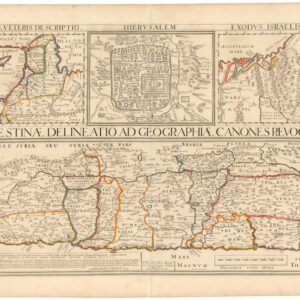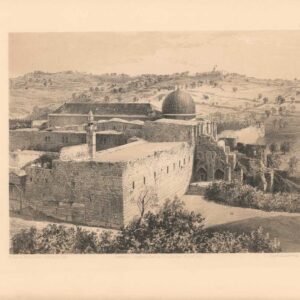1956 Israeli battlefield map of the Sinai Peninsula Campaign from the Second Arab-Israeli War (Suez Crisis).
[Suez Crisis Sinai Peninsula Map]
Out of stock
Description
[The Battlefield of the Sinai Campaign] שדה הקרב של מסע סיני.
This is a scarce and highly detailed military map issued by the General Staff of the Israeli Army as an overview of their campaign into the Egyptian Sinai Peninsula in 1956. The campaign was part of the Second Arab-Israeli War, an international conflict also known as the Suez Crisis (see context section below). The map was issued shortly after the war by the ‘education officer’ of the propaganda branch (as indicated in Hebrew at the bottom of the sheet).
Being a military-grade map designed to visualize the Israeli invasion of the Sinai, the map is stylistically straightforward in its expression and content. Toponyms are maintained throughout, always written in Hebrew but using Arab/Egyptian place names. The map’s graphics highlight multiple phases of troop movements from the Israeli border into the Sinai. The nature of these operations are explained in the legend in the lower right corner of the map (just above the regional inset).
Orange arrows delineate the three phases of the Israeli attack in considerable detail. The mapmaker illustrates Phase A using thick arrows in an orange outline, depicting four different incursion points, including one outside the Red Sea port of Eilat. Phase B is shown using large orange arrows with a dotted fill, revealing that the next phase of the attack consisted of two northern pushes into the interior. Here Israeli forces joined the initial invasion force at the oasis of Bir Gifgafeh and, further south, at the Parker Memorial. The initial invasion force included several contingents of paratroopers, who jumped in behind enemy lines as part of the first strike. These are shown on the map as a parachute without fill. From the Parker Memorial, the IDF pushed west, towards the Suez Canal, before veering south and continuing along the peninsula’s west coast.
While Phase C of the invasion also saw a two-pronged northern push on Lake Timsah, Ismailiye, and al-Qantara, the goal of this final leg of the attack was clearly to secure the Sinai Peninsula in its entirety. The map shows that the bulk of the Israeli invasion force was dedicated to taking the south at this stage. The key to accomplishing this objective was capturing the large oil refinery at Rās al-Sudr and then moving south along the coast, taking critical positions. Simultaneously, the forces that in Phase A had pushed across the border from Eilat also turned south along the east coast until they would finally meet up in Sharm el-Sheikh. As part of this large offensive, the troops on the ground were supported by the second wave of paratroopers landing behind al-Tūr (shown as a filled orange parachute).
Interestingly, the map also shows that the invasion of the island of Tiran, at the mouth of the Gulf of Aqaba, was part of the original plan. Control of this island was crucial, as its straits constituted Israel’s only maritime access to the Red Sea and the Indian Ocean. While the Israeli army only briefly occupied Tiran in 1956, the assessment that it was a necessary step was not far off; when Egypt blocked the Straits of Tiran to Israeli ships in 1967, this was the primary casus belli for the ensuing Six-Day War.
In addition to the phased troop movements, the map includes many features and infrastructure crucial to a military invasion. Features such as paved roads, towns and villages, wells and oases, railroad lines, oil depots, and airfields are among them. Different line types delineate formal borders and recent armistice lines. Finally, we have an orange delineation of Port Said and the northern part of the Suez Canal itself. This delineation identifies the area taken over by the French and British. It is a stark reminder that the Suez Crisis was an international conflict, primarily brought on by confrontations between the colonially-minded British and French and the Pan-Arab nationalist Gamal Abdel Nasser, Egypt’s president.
Context is everything
The Suez Crisis, also referred to as the Tripartite Aggression, Suez War, or Second Arab-Israeli War, was a diplomatic and military confrontation in late 1956 between Egypt on one side and Britain, France, and Israel on the other. In July of that year, President Nasser decided to nationalize the Suez Canal after Britain and the United States had withdrawn an offer to fund the Aswan Dam. Rescinding on this promise was anchored in the Cold War and Nasser’s flirtation with the Soviet Union. Nasser was keen to elevate Egypt, and indeed the entire Arab world, and become its great leader. To do so, he needed large unifying projects, and for this aim, he needed help from whatever side he could get it.
Nasser sought alliances that concerned Western powers, including formally siding with Mao Zedong at the height of tensions between China and Taiwan. From the point of view of the West, there was a global ideological battle between communism and free-market capitalism (and most other forms of freedom, for that matter), and if the Suez Canal came under the Soviet Union’s sphere of influence, it could disrupt access to Middle Eastern oil, and cause significant damage to Western economies. So, a plan was hatched to win control of the canal itself and oust Nasser and his nationalists from power.
The conflict was initiated by Israel’s invasion of the Sinai Peninsula, as is shown in great detail on this map. Britain and France issued a joint ultimatum and began bombing Cairo the same day. Despite continuous denials by all three governments, allegations soon emerged that the entire debacle had been planned beforehand by the three aggressors. Anglo-French forces withdrew by the end of the year, but Israeli forces remained until March 1957. In April, the canal was fully reopened to shipping. Both American and Soviet objections had forced the French and English to withdraw, returning control of the canal to an un-ousted Nasser. On the other hand, Israel did achieve some of her objectives, in particular as pertains to the brief occupation of Tiran, which secured more than a decade of passage through the straits for Israeli ships.
Cartographer(s):
Condition Description
Some spotting and discoloration; wear and minor loss along fold lines.
References



